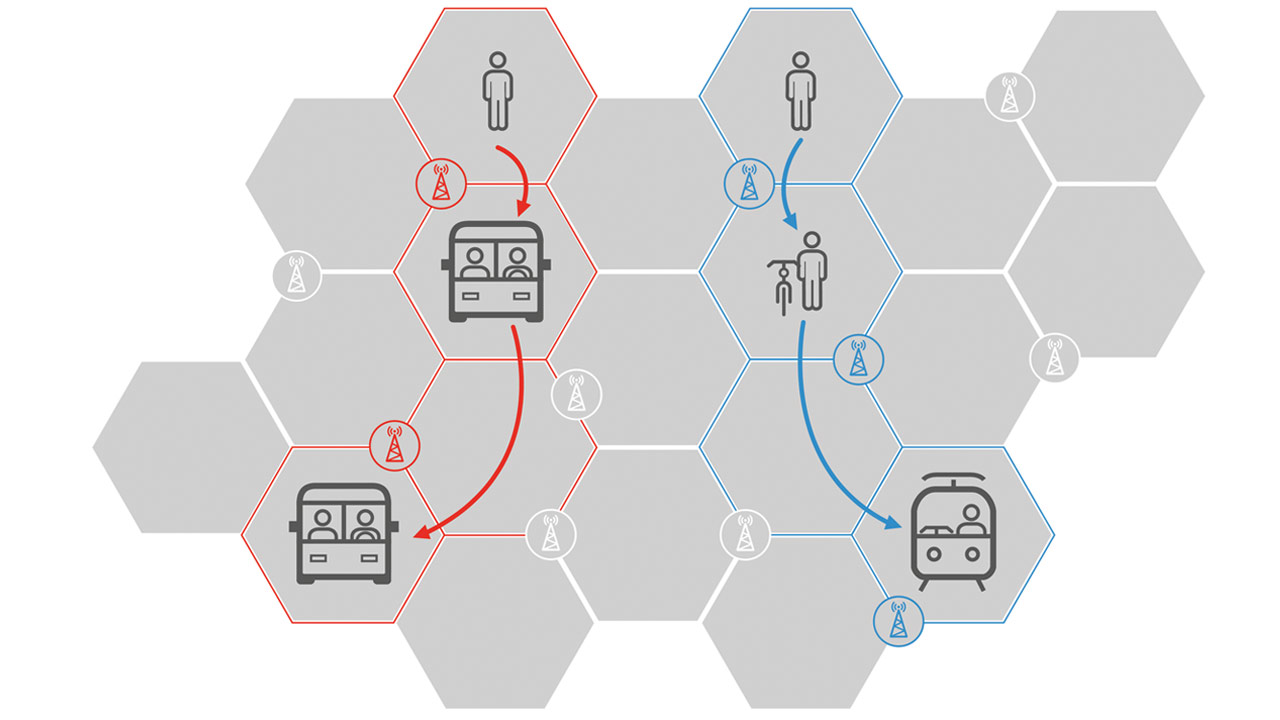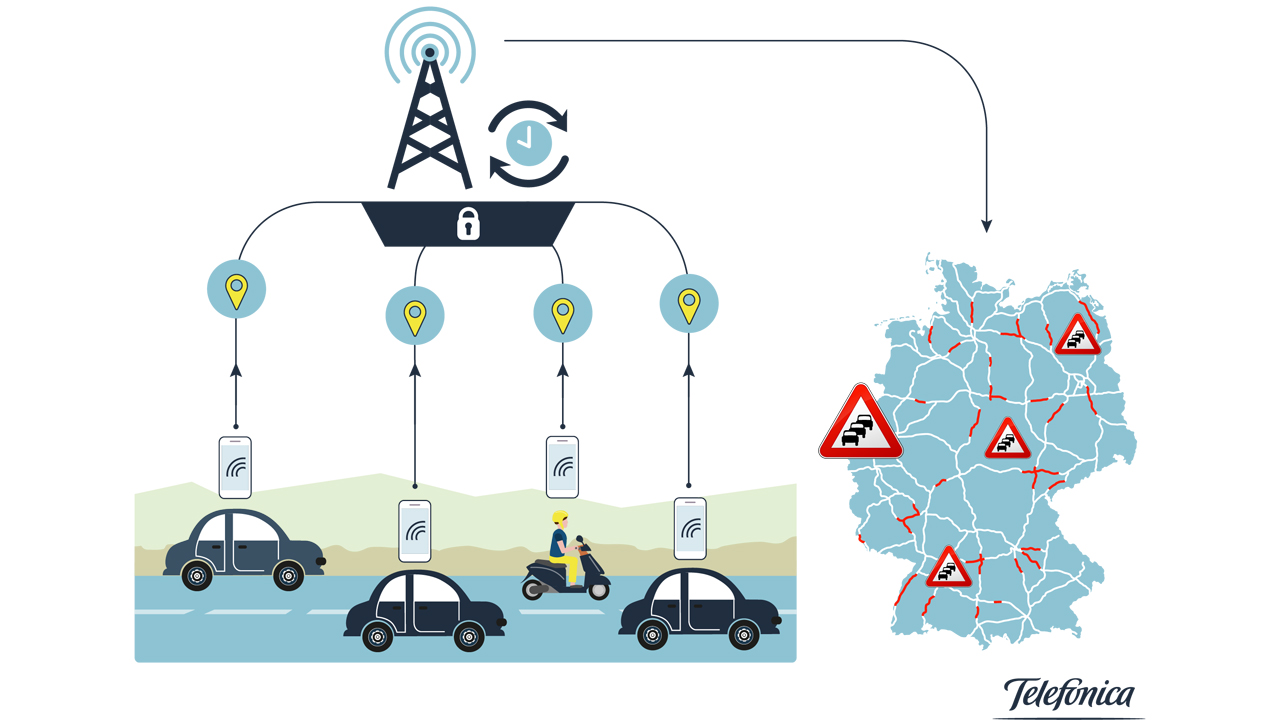28.02.2017
Smart data analysis for transport in Stuttgart:Fraunhofer IAO confirms the potential of mobile network data for transport planning
The overburdening of city transport systems is becoming an increasing challenge. But before cities can take concrete action, they need to gather precise traffic data. This is often very time consuming and expensive. A study by the Fraunhofer Institute for Industrial Engineering IAO in cooperation with Telefónica NEXT and the data analysis specialist Teralytics found that mobile network data can make a positive contribution to transport planning. To clarify, analyses were carried out for the city of Stuttgart with the help of anonymised and aggregated mobile network data, which provide detailed insights into the actual travel behaviour of Stuttgart residents. This gives an idea of the data’s potential.
The data treassure must be lifted

In Telefónica Germany’s normal operation, mobile network data is generated by over 44 million customers. This happens when mobile phones communicate with mobile cell sites when using the internet or making calls. This data is anonymised via a three-step process, which is certified by the TÜV, so that it is no longer possible to draw conclusions back to individual persons.With “Advanced Data Analytics”, the new Telefónica company, Telefónica NEXT, is eyeing the social and economic advantage that can be obtained from analysing such large, anonymised and aggregated volumes of data.
By assigning a mobile phone to the mobile cell sites, anonymised flows of movement can be calculated that represent around half the population of Germany. The central question of the study carried out was what added value for transport planning and what potential uses these flows of movement offer.
The strengths of mobile network data

„Recording mobility behaviour in cities across modes of transport is a complex undertaking. Our study shows that mobile network data can make a positive contribution to transport planning. The data is available in high spatial and temporal resolution, and provides new insight into the factors influencing urban transport”, explains Prof. Anette Weisbecker, deputy institute director of the Fraunhofer IAO.
Current transport planning relies, to a large extent, on manual recording in the form of surveys. Supplementary, real-time data sources, such as anonymised mobile network data, are a valuable addition. Compared to surveys, which are only conducted every one to ten years, mobile network data is available around the clock. It can minimise the number of expensive surveys and shorten the previous survey cycles. Another benefit is that no additional infrastructure is needed to collect mobile network data. The possibility of obtaining comprehensive information for the first time about non-users of mobility offers is also particularly interesting.
Thanks to these characteristics, complete journeys using different modes of transport can be understood, which was not previously possible as such. The mobile network data for Stuttgart, for example, shows that a lot of commuter traffic is directed through the state capital due to its basin location. However, the commuter flows are divided between road and commuter rail line, as is clearly apparent from the anonymised mobile network data. This possibility, of recording different modes of transport at the same time, could offer transport planners considerable added value in future.
The data could also help to examine time-limited events and external influencing factors. An analysis of the data during the Cannstatter Spring Festival and the Stuttgarter Weindorf shows the considerable impact of a public festival on the mobility behaviour of Stuttgart residents.
Where mobile network data could be used
In the short term, mobile network data serve to test and supplement existing transport models. In the medium term, the further development of special algorithms and models will allow for better planning of mobility systems and new findings on passenger transport. “The considerable potential of mobile network data can only be realised through the accompanying offer of corresponding analysis tools”, summarise the authors Alexander Schmidt and Tobias Männel.
The experts questioned also largely consider the new data source to be useful for transport planning. For example, they see great potential for route planning for local public transport. “With the help of mobile network data, it would be possible to obtain continuous information on general transport demand. This could supplement our own manual transport surveys, which we carry out less frequently. One advantage of this would be that we could save costs on occasional surveys - for example, for certain events”, says Thomas Hachenberger, general manager of the Stuttgart Transport and Tariff Association (VVS).
Study relies on expert interviews and test analyses for Stuttgart
In order to determine the potential of mobile network data for transport planning, the Fraunhofer IAO compared mobile network data against existing data acquisition methods, such as traveller surveys, automatic counting stations, or GPS data. In addition, 18 experts from companies, syndicates, research, and politics were interviewed on the data’s potential. To clarify the current possibilities of mobile network data, the Fraunhofer IAO, for example, carried out analyses for the city of Stuttgart with anonymised data from Telefónica Germany.
Important start for optimising the measuring method
Telefónica NEXT believes that the method’s further development will focus on being able to differentiate even more clearly between individual modes of transport in slow city traffic in future. This should be achievable especially through combination with other data sets. In addition, the method is to be used in other cities to optimise transport there.
The utilisation of data for business and social solutions is a global aim of Telefónica S.A. in the business area called “LUCA” and is realised in various countries using different products. With Telefónica NEXT, Telefónica Germany is creating solutions for the needs of the German market, for example with an anonymisation process developed in-house.